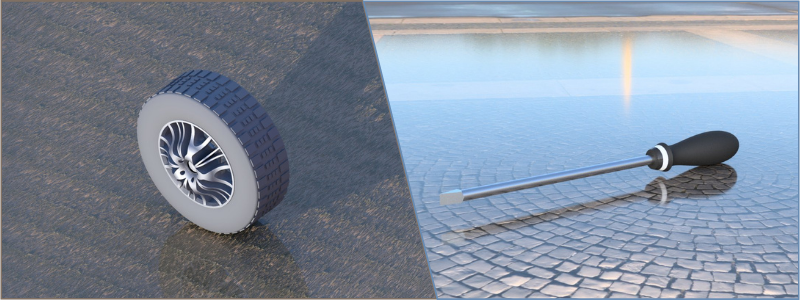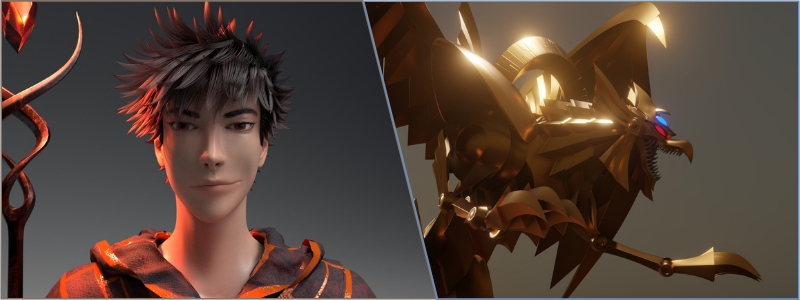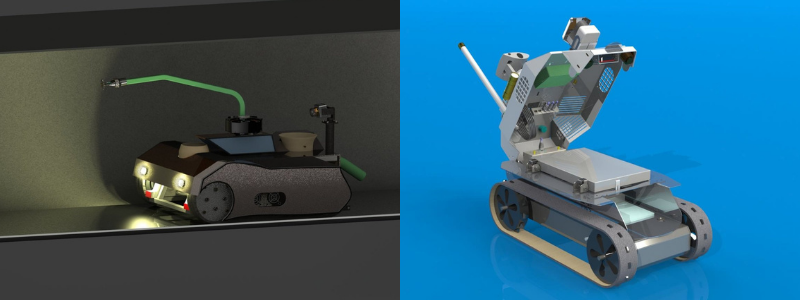A 3D animation happens when an otherwise static 3D object appears to be moving on a screen. Unlike in traditional animation, where the objects for every frame are drawn manually, the works in a 3D-animated scene are based on computer-generated imagery (CGI). The objects and their motions are configured using computer-assisted design (CAD) software.
Table of contents
- What does a company charge for 3D animation services?
- The production process of 3D animation
- First stage – preproduction
- Second stage – production
- Third stage – postproduction
- Alternatives to CGI-based 3D animation
- Estimated completion time of CGI 3D animation
- What are the hourly rates for 3D animators?
- How Cad Crowd can help
You don’t have to be able to draw manually when creating a 3D animation, and the skill can be helpful but not mandatory. Developing a detailed model (object) from scratch is a time-consuming task, so it is not an uncommon practice to use a ready-made asset as a starting point. For example, suppose an artist wants to create a 3D animation of a fictional creature with monstrous facial features and strange body proportions. In that case, it is easier to use a pre-designed asset as a starting point. After some modifications and refinements, the asset may look distinct from the original. There are plenty of online markets for such an asset, and some are free.
RELATED: What industries use 3D modeling services, and how does it benefit companies?
What does a company charge for 3D animation services?
Essentially, creating a 3D animation is an artistic work, and as such, it is challenging to determine standard pricing. The total cost is affected by various factors such as design, 3D assets required, turnaround time, whether or not the animation uses sounds or music, and to some extent, where the creator is based. Prices vary depending on complexity and project-specific requirements, including resolution and duration.
Artists and studios also have their considerations when setting up a pricing strategy. They can use a base price for their basic design service but charge extra fees for additional production processes required to complete the job. A particular studio may charge only $1,000 per minute of animation, but you can also get the higher-end choice that costs around $30,000 per second. There is a big gap between the bottom- and top-range options – a price difference signified only by the level of quality. Most people will choose a price point somewhere in the middle for most purposes, such as marketing, education, and business presentation. It should be far higher than the bottom end but not too close to the top for reasonable quality.
The production process of 3D animation
Every frame of a 3D-animated scene involves a multistage process, and it is almost like a 3D rendering service with a lot more elements blended into the final image. All features affect each other and the output quality, which means the whole process calls for unmistakable attention down to the tiniest detail, and failure to do so is likely to produce a sub-par result.

First stage – preproduction
This stage mainly revolves around the creation or preparation of the raw materials required to build the basis of the 3D animation:
- Script and storyboard – The process is similar to that of 2D animation. Animators must first understand the script (if any) and storyline the animation should convey. It gives an idea of the visual flow, hence facial expressions and gestures created within the animation. Assuming there is a script, later on, the animation will require a proper synchronization between the speech and lip movements of the characters for a realistic effect.
- 3D assets – Every object in the scene is a 3D model. Some animators purchase ready-made assets and then modify them by the descriptions stated in the project brief. If the project requires the use of unique characters, animators may have to create 3D models from scratch.
- Textures and colors – Bare-boned models are wrapped in textured and colored layers to give the sense of surface and volume. The process is done by overlaying 2D images onto the 3D models. Certain characters have complex properties, such as an eye that simultaneously absorbs and reflects light. Product 3D animation services typically use a 3D model representing the physical product in a photorealistic way.
RELATED: What Is 3D rigging, and how is it used for 3D character animation?
- Rigging – A rigged 3D model refers to a 3D object already configured for all the natural movements. Think of it as putting a skeleton inside a human or animal figure. The joints are pivots for movable sections of the constitution to represent the natural range of motions. Every 3D object can be rigged. Once the raw materials are ready, the process moves toward the main production task.
Second stage – production
The next stage involves the manipulation of 3D models. Animators give the models motions as required by the storyline and script. Additional visual elements such as lights and visual effects are built in this stage too.
- Animation – The available range of motion depends on the rigging process. In a 3D character animation service that resembles a person or an animal, the rigging should imitate the natural skeletal figure of the character it is supposed to represent. The idea is to give the object a maximum range of motions but not beyond what is naturally possible limits. However, animators can do excessive rigging if the storyline calls for it.
- Lighting – As mentioned earlier, creating a 3D animation is like the more sophisticated version of a rendering process. The basic principle remains, in the sense that animation also needs good lighting for it to appear realistic. If an image only needs a set of lighting configurations, an animation takes one for each frame, depending on the motions. For instance, a moving cloud blocks the sun partially in one second and then entirely in the next. An object in motion also casts a different shadow from a static one.
- Visual Effects (VFX) and composite – Additional special effects are added to create a real atmospheric sense in the virtual world, such as the use of wind and rain. And then, there is the compositing process in which the scene is the result of blending two or more files from separate sources.
To speed up the process, animators only configure the positions of the 3D models for all the keyframes. In between those frames, the computer interpolates the natural sequence of motions. One second of a scene may contain at least twenty-four frames (24fps) for smooth animation. Furthermore, there can be more than just two keyframes within a second. It involves a lot of work by the 3D animation designer, even for a minute of 3D-animated video.
Third stage – postproduction
At this point, the visual parts of the animation are ready to use. Some final touches and revisions take place in the postproduction stage.
- Sound Effects – Music and sound files are overlaid on the animation. If an object or character speaks, the facial expressions and speeches must be synchronized.
- Review and Edit – Animators play all the scenes in sequence to look for possible mistakes. Minor and major changes are made as needed.
- Render – The final step involves compiling and converting animation files into one video format, ready to release.
Of course, large studios like Pixar and Disney employ much more complex operations in every single stage compared to small agencies. That said, whether the animation is done by a small team of freelancers or a big company specializing in 3D animation services with full-time professionals, the production process undergoes the same basic procedures.

Alternatives to CGI-based 3D animation
There are only two basic types of 3D animation. Apart from the CGI-based, the physical type known as “Stop-motion” uses actual objects rather than digital models. The raw materials of stop-motion animation are photographs of physical objects captured in various poses in the sequence. In many respects, the works involved are like traditional animation, but stop-motion uses photos instead of drawings. Still, images are rearranged in a particular order to build a scene and create the illusion of movement. For instance, if an object has to rotate 360 degrees, it must be photographed multiple times to represent a full motion. At a thirty-degree increment, there should be thirteen photos.
The production process of stop-motion can be very long, depending on the number of objects and motion fluidity desired. More photographs allow for smoother animation. If you want a ten-degree increment for the rotation, the 3D animation professional must photograph the object thirty-seven times. Things get even more complicated when some frames require different lighting configurations. Stop-motion comes in several forms:
- Claymation – objects are made of clay or similar material. Animators sometimes use metal skeletons to make the clay structure more rigid.
- Puppets – some animators use traditional instruments instead of clay. The instruments also need skeleton rigs to remain sturdy enough.
Other types, including cut-outs and silhouettes, are categorized under stop-motion, but they are two-dimensional.
RELATED: Product CGI: 7 ways 3D modeling can help market your new product
Estimated completion time of CGI 3D animation
Again, there is no standard timeline as it all depends on variables like complexity level, equipment, and the number of people working on the project. The timeline can be divided into stages as follows.
| Stages | Notes | Completion (approximation) |
| Creative brief | Write a project scope | Three days |
| Script | Write the dialog | Two days |
| Storyboard | Visualize the script | Two weeks |
| 3D modeling | High-quality character. Simple products are quicker. | Two weeks |
| Rigging | Complex character. A few minutes of animation | Two months |
| Animation | A higher frame rate takes more time | One month |
| Sound effects | Create a score and soundtrack | One week |
| Rendering | With a render farm | One week |
Using eight working hours per day (five working days per week, twenty working days per month), the approximate completion time is ninety-five days or seven-hundred-and-sixty hours. If you hire a mid-level freelancer charging you $45 per hour, the cost would be $34,200 for a few minutes of high-quality 3D animation with complex characters and relatively quick rendering time. Product animation is likely to cost less due to a lower level of complexity, but quality should remain equally good. A freelancer may negotiate the price even further in case of a small budget, such as a longer completion time or lower resolution render.
If a project needs to be done quickly, a 3D animation design can be finished quicker, although it would be resource-intensive. You would need to hire more people on the team and use high-performance computers. Another factor that affects completion time is communication between the group and client, and everybody involved in the project needs to be on the same page during each phase.
What are the hourly rates for 3D animators?
“You get what you pay for” rings true in the 3D animation market, although in rare cases, an affordable service delivers a result equal in quality to the pricier one. Lower cost does not necessarily mean poor animation, and a team of individual freelancers is likely to charge less than a big-name studio. The advent of cloud computing makes it easier for people to work together on the same project, even when they are not sitting in the same room. They can be in different cities or countries but still be able to collaborate just as quickly, thanks to cloud storage or cloud-based 3D animation software.
Individual (team of) freelancers
Budget is always an important consideration, whether you need a short 3D-animated video or an hour-long film. A small budget forces you to look for affordable services to get the job done with reasonable quality. Freelancers will most likely charge lower prices than a studio because they don’t have much overhead, such as renting an office or sharing their revenues with the bosses. They work from their properties using personal computers. The only overhead probably is electricity and the software license fee.
Freelancers can be flexible in terms of pricing, too. The fee is pretty much negotiable based on the complexity of the project. They might use a standard pricing strategy, but the cost can be either higher or lower than the base rate. If you think the project is not overly complex and a quick turnaround time is not a concern, chances are you can secure a good deal. Freelance 3D animators are great for such projects as short marketing content, product presentations, school lesson materials, and personal (non-commercial) use.

A possible drawback is that a freelancer typically specializes in a single aspect of 3D animation work. One who does the 3D modeling and rigging may not offer sound effects and VFX services, and vice versa. To get a complete fully-functioning animation, you must hire multiple freelancers. A team must include a scriptwriter/storyboard artist, a 3D modeler/rigger, and an animator/renderer. Only scriptwriting and modeling can work simultaneously to build the story and 3D assets. Once the raw materials are ready, the animator’s turn takes over. In addition to experience level, the hourly rates of freelance 3D animators vary based on location. The table below shows the estimated average rate of animators based in the United States.
| Level | Experience | Hourly Rate |
| Junior | < 2 years | $30-45 |
| Mid-level | 2 – 4 years | $45-80 |
| Expert | > 4 years | $80-160 |
The average hourly rate is similar to other developed countries like Canada, the United Kingdom, Australia, and Western European nations. Educational background, qualification, certification, and work experience also determine the hourly rate. Freelance 3D animators with an experience level of two years will not offer their services at the same rate as their more senior counterparts.
Animation studio
The easier but more expensive option is to hire a professional 3D animation studio. The most significant advantage of hiring a studio is the in-house production team, and everyone who works on your project is doing the job in the same office. As trivial as it may seem, direct collaboration plays a massive role in helping cut turnaround time. They show up for work simultaneously and collaborate in a face-to-face environment, allowing them to solve any potential problem quicker.
A dedicated project manager bridges communication between the client and the actual production team. A project manager does not simply relay questions and answers but understands all the details about the work. Even questions as diverse as invoices, billing, progress, deliverables, file format, and estimated completion time will be answered by one point of contact. What you get is an accurate end-to-end production service.
The production team already knows at least the big picture right from the start. It wouldn’t be an uncommon practice for a studio to work on all elements of the 3D animation simultaneously. For instance, while the script is still in the writing process, the 3D modeling service may begin drawing the objects or characters. The person responsible for sound effects is already working on a synthesizer.
Although they are built around the same time, each has a different difficulty level and, therefore, completion speed. They are also separate parts, which must be put together later in the project. Certain elements are impossible to create simultaneously, such as modeling, rigging, animation, voice-over, and rendering.
How Cad Crowd can help
Nevertheless, it is not impossible to bring together freelancers who act as a team. It is one of the signature services of Cad Crowd, a 3D design freelancing site based in California, the United States, and Alberta, Canada. Instead of working with each freelancer for separate project parts, you communicate with a manager to oversee the collaboration and progress. Everything becomes simpler not only in terms of teamwork but also in payment. Or, for even more simplified management, hire a freelancer who offers a turnkey 3D animation service.
You get to remove unnecessary complexities from the project, and the cost can be even lower thanks to one-on-one collaboration. Cad Crowd offers the best of both worlds by giving you the affordability of experienced freelancers and easy project management for a guarantee of accuracy and quality.

This was extremely helpful! Now I know what to do when I get my studio and start working hard. Thanks a lot!